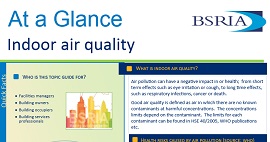At a glance - Indoor air quality
Air pollution can have a negative impact on health; from short term effects such as eye irritation or cough, to long time effects, such as respiratory infections, cancer or death. According to the World Health Organisation (WHO), ambient (outdoor) air pollution in 2012 was estimated to have caused 3.7 million premature deaths worldwide. Some 88% of those premature deaths occurred in low-to-middle-income countries, and the greatest number in the WHO Western Pacific and South-East Asia regions.
Good air quality is air in which there are no known contaminants at harmful concentrations.
In August 2016, BSRIA published a new topic guide ‘TG10/2016 At a glance - Indoor Air Quality’. This is one of a number of of BSRIA at a glance topic guides intended to introduce readers to key industry topics and suggesting further reading. The guide is aimed at those looking for introductory information about indoor air quality, including its definition, history and prevalence. It also provides information on types of contaminants and their exposure limits as well as a useful site map.
BSRIA’s Asset Performance Team Leader, Blanca Beato-Arribas said: “People spend approximately 80% of their time indoors. There is enough evidence that links poor air quality with permanent damages to health or even death. Therefore, we should be aware of the quality of the air that we breathe both at home and at work, and ensuring good indoor air quality at work should be a priority for employers.”
The new guide is available to download free from BSRIA’s website.
--BSRIA
[edit] Related articles on Designing Buildings
- Air filtration and clean Indoor air quality standards.
- Air quality.
- Air Quality Taskforce.
- Bringing a breath of fresh air to the design of indoor environments.
- BREEAM Indoor air quality plan.
- BREEAM Indoor air quality Ventilation.
- BREEAM Indoor pollutants VOCs.
- BS ISO 17772 - Indoor environmental quality.
- BSRIA articles on Designing Buildings Wiki.
- BSRIA responds to UK Air Pollution Report.
- Building performance evaluation.
- Clean indoor air for healthy living - New air filter standards.
- Ensuring good indoor air quality in buildings.
- Health effects of indoor air quality on children and young people.
- Indoor air quality.
- Indoor environmental quality.
- Minimum efficiency reporting value MERV.
- The history of non-domestic air tightness testing.
Featured articles and news
RTPI leader to become new CIOB Chief Executive Officer
Dr Victoria Hills MRTPI, FICE to take over after Caroline Gumble’s departure.
Social and affordable housing, a long term plan for delivery
The “Delivering a Decade of Renewal for Social and Affordable Housing” strategy sets out future path.
A change to adoptive architecture
Effects of global weather warming on architectural detailing, material choice and human interaction.
The proposed publicly owned and backed subsidiary of Homes England, to facilitate new homes.
How big is the problem and what can we do to mitigate the effects?
Overheating guidance and tools for building designers
A number of cool guides to help with the heat.
The UK's Modern Industrial Strategy: A 10 year plan
Previous consultation criticism, current key elements and general support with some persisting reservations.
Building Safety Regulator reforms
New roles, new staff and a new fast track service pave the way for a single construction regulator.
Architectural Technologist CPDs and Communications
CIAT CPD… and how you can do it!
Cooling centres and cool spaces
Managing extreme heat in cities by directing the public to places for heat stress relief and water sources.
Winter gardens: A brief history and warm variations
Extending the season with glass in different forms and terms.
Restoring Great Yarmouth's Winter Gardens
Transforming one of the least sustainable constructions imaginable.
Construction Skills Mission Board launch sector drive
Newly formed government and industry collaboration set strategy for recruiting an additional 100,000 construction workers a year.
New Architects Code comes into effect in September 2025
ARB Architects Code of Conduct and Practice available with ongoing consultation regarding guidance.
Welsh Skills Body (Medr) launches ambitious plan
The new skills body brings together funding and regulation of tertiary education and research for the devolved nation.
Paul Gandy FCIOB announced as next CIOB President
Former Tilbury Douglas CEO takes helm.
UK Infrastructure: A 10 Year Strategy. In brief with reactions
With the National Infrastructure and Service Transformation Authority (NISTA).
























